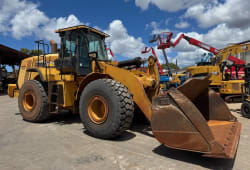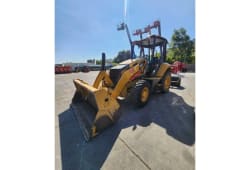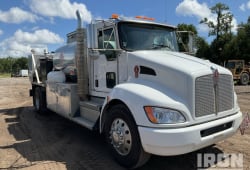Maximize Your Tax Savings with Section 179 Before The Year Ends
5 Min read
)
October 23, 2023
If you’re considering upgrading your fleet or adding new heavy equipment to your operations, 2025 is a prime year to act. Thanks to Section 179 of the IRS Tax Code, business owners can deduct the full purchase price of qualifying equipment in the same year it’s put into service-delivering immediate tax relief.
But there’s a catch: the equipment must be purchased, delivered, and in use by December 31, 2025. So now’s the time to take advantage.
Section 179: Your 2025 Tax Savings Opportunity
For 2025, the Section 179 deduction limit has increased to $1,200,000, with a phase-out threshold at $3,000,000. This generous incentive applies to both new and used heavy equipment, including excavators, haul trucks, bulldozers, cranes, and more.
That makes it an essential tool for companies in construction, logistics, infrastructure, and related industries looking to save big and grow smarter.
Example Scenario: See the Tax Benefits in Action
Example 1: Mid-Sized Purchase
You purchase a 2023 Terramac RT9 Haul Truck listed at $270,000. Under Section 179, you can deduct the entire cost in 2025.
If your business is in the 30% tax bracket, this could mean a tax savings of $81,000-all while retaining the truck as an asset.
Example 2: Larger Investment
You invest in a 2024 Caterpillar D10T2 Bulldozer priced at $2,395,000.
Here’s how it breaks down in 2025:
Deduct $1,200,000 using Section 179
Apply bonus depreciation to the remaining $1,195,000
The result? Substantial tax savings and a significant reduction in your taxable income for the year.
Reminder: Equipment must be placed in service by December 31, 2025, to qualify for either deduction.
Why Contractors Should Act Now
:format(webp))
1. Time is Running Out
Waiting until the end of the year puts you at risk of missing the deadline. Take action now to avoid last-minute delays or delivery issues that could disqualify your purchase.
2. Equipment Prices Are Climbing
Inflation and ongoing supply chain issues are pushing equipment costs higher. Buying now locks in today’s pricing while still benefiting from the 2025 deduction limits.
3. Bonus Depreciation is Still Available
Even if your purchase exceeds the Section 179 cap, you can apply bonus depreciation to deduct the remaining cost-offering a powerful, combined tax-saving strategy.
Bonus Depreciation in 2025
Alongside Section 179, bonus depreciation is another powerful tax tool for equipment buyers — and the rules changed in 2025.
100% expensing is back: For qualified property placed in service after January 19, 2025, businesses can immediately deduct 100% of the cost.
Transition period: Equipment placed in service between January 1 and January 19, 2025 is limited to a 40% bonus depreciation rate.
Permanent rule: The One Big Beautiful Bill Act made 100% bonus depreciation permanent for most qualified property.
How it works with Section 179: You apply Section 179 first (up to its $2.5M limit in 2025). Then bonus depreciation can cover the remaining cost — often wiping out the entire purchase price for tax purposes.
This change is especially valuable for larger purchases where Section 179 alone may not cover the full cost. Together, Section 179 and bonus depreciation allow many businesses to expense nearly all their qualifying equipment in the year it’s placed in service.
Financing + Section 179 = Smart Business Move
Here’s the best part: you don’t have to pay in full upfront to claim the deduction.
For example, if you finance a $270,000 haul truck, you can:
-Deduct the full $270,000 in 2025
-Spread your payments over time
-Maintain cash flow while lowering your taxable income
Just make sure the equipment is in service by December 31, 2025, even if payments extend beyond that date.
What’s New in 2025?
The One Big Beautiful Bill Act brought major updates to Section 179:
Deduction Limit: $2,500,000
Phase-Out Threshold: $4,000,000
Applies to: Most business-use equipment (new or used), off-the-shelf software, and some building improvements (roofs, HVAC, fire protection, security systems)
Effective: For tax years beginning after December 31, 2024
Indexed for inflation: These numbers will rise in future years
Bonus depreciation is also still available, but it’s phasing down:
2025: 60%
2026: 40%
2027: 20%
2028: 0% (unless Congress extends it)
Keep in mind: Section 179 can’t create a loss -- you can only deduct up to your business income for the year. Unused deductions can be carried forward.
Invest Now, Save Now
Section 179 is one of the most contractor-friendly tax codes in the IRS playbook, but it’s strictly time-sensitive. Every dollar you spend on qualifying heavy equipment before December 31, 2025, could come back as tens of thousands in tax savings.
At Boom & Bucket, we offer a robust selection of high-quality used heavy equipment, from bulldozers and excavators to trucks and cranes. Our team is ready to help you find the right machine-and make sure it qualifies for the 2025 Section 179 deduction.
Don’t Wait-Secure Your Equipment & Savings Today
Act now to take full advantage of the 2025 Section 179 limits. Your business will benefit from:
Lower taxable income
Equipment ownership
Improved operational capacity
Increased return on investment
Browse our inventory and get your equipment in service before the clock runs out.
Need Help? Start with the IRS
For complete details, consult:
IRS Form 4562 - Depreciation and Amortization
IRS Publication 946 - How to Depreciate Property
Or speak with your tax professional
Make 2025 the year you invest, grow, and save with smart equipment choices and Section 179 on your side.

Rex Walz is Boom & Bucket's Manager of Supplier Relations, bringing over a decade of experience in B2B sales and heavy equipment solutions. With a background spanning government, construction, industrial, and commercial sectors, he has a proven track record of driving growth and building trusted customer relationships. At Boom & Bucket, Rex is passionate about helping partners succeed while advancing the company's mission to create the most trusted marketplace for heavy equipment.














